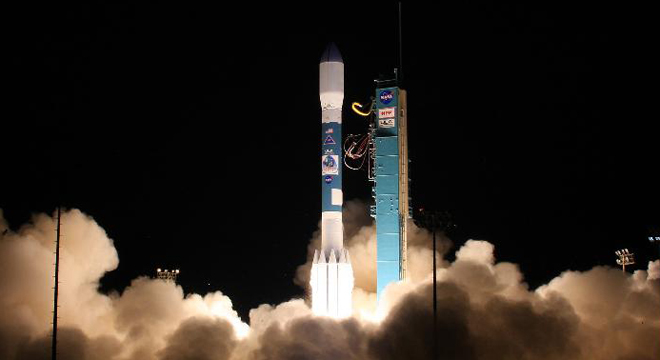NASA early Friday morning successfully launched its latest earth observing satellite, the lengthily-monikered National Polar-orbiting Operational Environmental Satellite System Preparatory Project (NPP, for short), which will be used to monitor weather patterns and climate change from an orbit 512 miles above Earth’s north and south poles.
The $1.5 billion, 4,600-pound satellite was stowed aboard a Delta II rocket, which blasted off at 5:48 a.m. off from Vandenberg Air Force Base in California.
Watch NASA’s video of the launch here and another one from an amateur observer here on YouTube:
“NPP is critical to our understanding of Earth’s processes and changes,” said NASA Deputy Administrator Lori Garver in a news release. “Its impact will be global and builds on 40 years of work to understand our complex planet from space. NPP is part of an extremely strong slate of current and future innovative NASA science missions that will help us win the future as we make new discoveries.”
The satellite contains five instruments that will be used to monitor over 30 variables, including atmospheric moisture and pressure, ozone levels, thermal radiation ocean temperature and more, in addition to capturing “visible and infrared views of Earth’s dynamic surface processes, such as wildfires, land changes, and ice movement.”
NASA is working with the National Oceanic and Atmospheric Organization on the mission, which is expected to last five years. As such, the satellite’s data will be fed into NOAA climate and weather forecast modeling tools. It is expected to beam back 4 terabytes of data every day, equivalent to 800 DVDs, according to SPACE.com.
As NOAA explains on its website about its role “NOAA meteorologists use these [satellite data] products, especially measurements of the distribution of moisture and heat in the atmosphere, to improve forecasts.” The agency notes that the new source of data could help improve weather forecasts of extreme events, such as the “the major snowstorms that struck the Atlantic Coast in February 2010 (“Snowmageddon”) and paralyzed New York City in December 2010,” boosting the predictive modeling time by weeks.
NPP is actually just the first step in NASA’s National Polar-orbiting Operational Environmental Satellite System, a new program designed to replace older climate and weather monitoring satellites currently in orbit with a new set of six satellites. For instance, NOAA notes that the NPP will begin “begin replacing data from the NOAA-19 satellite,” the final satellite in its Polar Operational Environmental Satellites, launched in 2009.
But the program, proposed in 1994, suffered severe “management deficiencies” and severe cost overruns, ballooning from $6.5 billion to a total cost of $13 billion, and was last year scaled back by order of the White House to encompass four new satellites instead of six. The White House blamed the conflicting “perspectives and priorities” of the three agencies originally involved in the project, the Air Force, NASA and NOAA. The Air Force has since exited the project.
NPP itself got the go ahead after years of delays (it was originally set to fly in 2006, but suffered numerous technical malfunctions and cost overruns, an Office of Inspector General audit of NASA revealed) and a last minute delay of three days. The launch also wasn’t affected by the news that Bloomberg broke yesterday that two other NASA earth-observing satellites had been repeatedly hacked in 2007 and 2008.
Still, in spite of (or perhaps because of) the project’s messy history, Friday’s launch was a celebratory affair, with NASA inviting some 20 random Twitter followers of its account to watch the launch, and (what else?) tweet about it. You can read their coverage here.
The Delta II rocket that delivered the satellite into orbit also launched five research nanosatellites, “CubeStats,” each about 4 inches long, designed by various universities as part of NASA’s educational outreach.
Correction: This article originally misstated the cost of the satellite as $1.5 million instead of $1.5 billion. It has since been corrected. We regret the error.









